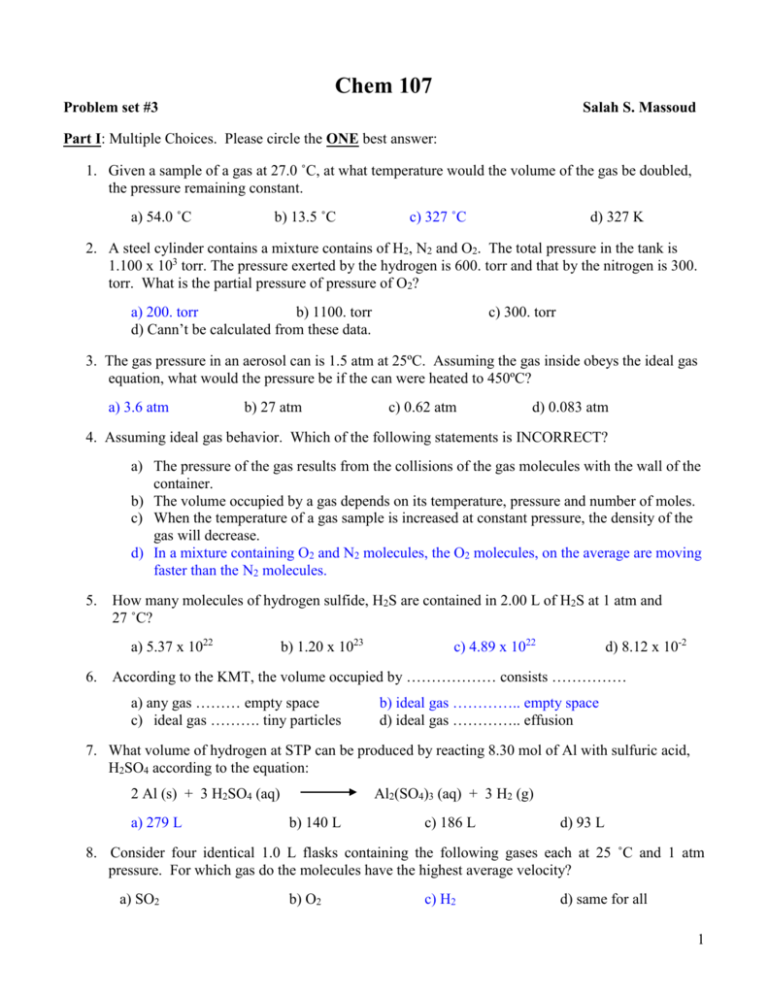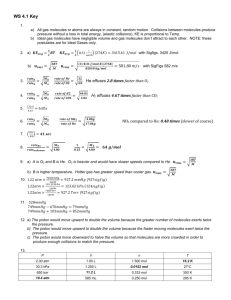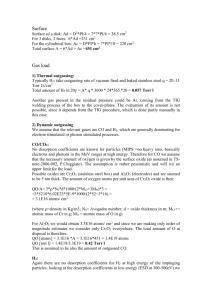Problem Set 3
advertisement

Chem 107
Problem set #3
Salah S. Massoud
Part I: Multiple Choices. Please circle the ONE best answer:
1. Given a sample of a gas at 27.0 ˚C, at what temperature would the volume of the gas be doubled,
the pressure remaining constant.
a) 54.0 ˚C
b) 13.5 ˚C
c) 327 ˚C
d) 327 K
2. A steel cylinder contains a mixture contains of H2, N2 and O2. The total pressure in the tank is
1.100 x 103 torr. The pressure exerted by the hydrogen is 600. torr and that by the nitrogen is 300.
torr. What is the partial pressure of pressure of O2?
a) 200. torr
b) 1100. torr
d) Cann’t be calculated from these data.
c) 300. torr
3. The gas pressure in an aerosol can is 1.5 atm at 25ºC. Assuming the gas inside obeys the ideal gas
equation, what would the pressure be if the can were heated to 450ºC?
a) 3.6 atm
b) 27 atm
c) 0.62 atm
d) 0.083 atm
4. Assuming ideal gas behavior. Which of the following statements is INCORRECT?
a) The pressure of the gas results from the collisions of the gas molecules with the wall of the
container.
b) The volume occupied by a gas depends on its temperature, pressure and number of moles.
c) When the temperature of a gas sample is increased at constant pressure, the density of the
gas will decrease.
d) In a mixture containing O2 and N2 molecules, the O2 molecules, on the average are moving
faster than the N2 molecules.
5.
How many molecules of hydrogen sulfide, H2S are contained in 2.00 L of H2S at 1 atm and
27 ˚C?
a) 5.37 x 1022
6.
b) 1.20 x 1023
c) 4.89 x 1022
d) 8.12 x 10-2
According to the KMT, the volume occupied by ……………… consists ……………
a) any gas ……… empty space
c) ideal gas ………. tiny particles
b) ideal gas ………….. empty space
d) ideal gas ………….. effusion
7. What volume of hydrogen at STP can be produced by reacting 8.30 mol of Al with sulfuric acid,
H2SO4 according to the equation:
2 Al (s) + 3 H2SO4 (aq)
a) 279 L
Al2(SO4)3 (aq) + 3 H2 (g)
b) 140 L
c) 186 L
d) 93 L
8. Consider four identical 1.0 L flasks containing the following gases each at 25 ˚C and 1 atm
pressure. For which gas do the molecules have the highest average velocity?
a) SO2
b) O2
c) H2
d) same for all
1
9. Assuming ideal behavior. Which of the following statements is INCORRECT?
a) At the same temperature CO2 and C3H8 molecules have the same velocity.
b) At the same temperature CO2 and C2H6 molecules have the same kinetic energy.
c) Under the same conditions, equal moles of CO2, C3H8, O2 and He would have the same
volumes.
d) The rate of effusion of O2 is four times faster than the rate of H2 molecules.
10. The assumptions of the MKT are most likely to be correct under what conditions?
a) high T & high P
c) low T & high P
b) high T & low P
d) low T & low P
11. What do these have in common?
20
19 -
Ne
a) the same number of protons
c) the same number of electrons
24
F
Mg2+
b) the same number of neutrons
d) the same size
12. The energy of a photon is greatest in the case
a) X-rays
c) visible light
b) ultraviolet
d) infrared
13. An atom has a valence shell electron configuration of ns1. To which group of elements in the
periodic table does it belongs?
a) transition elements
c) alkaline earth metals
b) lanthanides
d) alkali metals
14. The number of unpaired electrons in a gaseous selenium atom is
a) 2
b) 3
c) 5
d) 0
15. Which pair of particles has the same number of electrons?
a) F-, Mg2+
b) Ne, Ar
c) Br-, Se
d) Al3+, P3-
16. The orbitals of 2p electrons are often represented as being
a) elliptical
b) tetrahedral
c) dumbbell shaped
d) spherical
17. Which set of quantum numbers is correct and consistent with n = 4?
a) ℓ = 3
mℓ = -3
ms = + ½
b) ℓ = 4
mℓ = +2
ms = - ½
c) ℓ = 2
mℓ = +3
ms = + ½
d) ℓ = 3
mℓ = -3
ms = + 1
18. Which of these electron configurations could represent the ground state of the p valence electrons
of carbon?
a)
↑↓
b)
↑
c)
↑↑
d)
↑
↓
↑
2
19. Which of the following statements is false?
a) An electron transition from n = 3 to n = 1 gives off energy.
b) Light emitted by an n = 4 to n = 2 transition will have a longer wavelength than that from n = 5
to n = 2 transition.
c) A sublevel of ℓ = 3 has a capacity of ten electrons.
d) An atom of group 13 has three unpaired electrons.
20. Which of the following elements has the smallest atomic radius?
a) Si
b) P
c) S
d) F
21. Which element has the greatest electron affinity?
a) Ge
b) Se
c) Sn
d) Te
22. Which element has the lowest ionization energy?
a) Sn
b) Ge
c) Se
d) Te
23. Which of the following is paramagnetic with three unpaired electrons?
a) Li
b) Al
c) As
d) S
24. Which of the following is the ground state electron configuration of zinc?
a) [Ar] 3s2 3d10
c) [Ar] 4s2 4d10
b) [Ar] 4s2 3d10
d) [Ar] 3s2 3p6 4s2 3d10
25. Which of the following isoelectronicspecies would have the largest radius?
a) N3-
b) Al3+
c) Ne
d) F-
26. Which combination of atoms would most likely to produce a covalent bond?
a) K, O
b) Cu, Se
c) B, F
d) Fe, S
27. Which is the best Lewis structure for OF2?
a) F=O-F
b) F-O-F
c) F=F-O
d) F-O-F
28. Which of the following species does not obey the octet rule?
a) CO2
b) NH3
c) BF3
d) H2O
29. How many electron pairs are there around the central atom in the Lewis structure of SeF4?
a) 2
b) 3
c) 4
d) 1
c) OF2
d) H2S
30. Which of the following would not be bent?
a) SO2
b) BrCN
31. What type of hybrid orbitals are used by S in SF4?
a) sp
b) sp2
c) sp3
d) sp3d
3
Part II
1. For the following species:
NO2-
XeF2
BrCN
N2O (oxygen is terminal)
a) Draw the Lewis structure for each ion or molecule, draw the resonance structures, if there is any
then, predict:
b) the molecular shape of the ion
c) hybridization of the central atom
d) number σ and π bonds
e) bond angle
Part III Show all work for full credit. Please express all answers with proper units and correct
number of significant figures.
1. Consider the following reaction:
2 KMnO4 (aq) + 16 HCl (aq)
2 MnCl2 (aq) + 5 Cl2 (g) + 8 H2O (l) + 2 KCl (aq)
a) How many milliters of 0.50 M KMnO4 are required to react with 75.0 mL of 6.0 M HCl?
b) What is the volume of Cl2 gas (in liters) at STP that produced by the reaction of 75.0 mL of
6.0 M HCl with KMnO4?
2. If 7.25 g of Al and 30.7 mL of 1.22 M HNO3 are allowed to react according to the equation
below. What is the volume of hydrogen in liters that produced at 699 torr and 27˚C?
2 Al (s) + 6 HNO3 (aq)
3 H2 (g) + 2 Al(NO3)3 (aq)
3. Calculate the density of ammonia gas, NH3 at 24 ˚C and 738 torr.
4. a) Calculate the wavelength in nanometers in the H-atom spectrum that arises from the electron
transition of n = 5 to n = 2.
b) In what spectral region does this transition occur?
c) Is energy absorbed or emitted?
d) How many emission lines are possible for the transition from n =5 to all lower energy levels?
Answers: Part I-Multiple Choices:
1) c
9) c
17) a
25) a
2) a
10) b
18) d
26) c
3) a
11) c
19) c
27) b
4) d
12) a
20) d
28) c
5) c
13) d
21) b
29) d
6) b 7) a
8) d
14) a 15) a
16) c
22) a 23) c
24) b
30) b
31) d
Part-II:
N
O
N
O
Xe
3
F
o
{linear, sp d, 180 , 2 & 0}
N
O
N
N
O
N
N
O
O
{angular, sp2, < 120 o, 1 & 1}
F
N
N
C
Br
o
{linear, sp, 180 , 2 & 2}
O
o
{linear, sp, 180 , 2 & 2}
Part III-Calculations:
1) a- 113 mL, b- 3.15 L of Cl2 gas
2) HNO3 is L.R, 0.501 L of H2
3) 0.677 g/L
4









